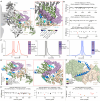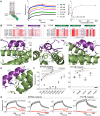Molecular basis for plasma membrane recruitment of PI4KA by EFR3
- PMID: 39705356
- PMCID: PMC11661448
- DOI: 10.1126/sciadv.adp6660
Molecular basis for plasma membrane recruitment of PI4KA by EFR3
Abstract
The lipid kinase phosphatidylinositol 4 kinase III α (PI4KIIIα/PI4KA) is a master regulator of the lipid composition and asymmetry of the plasma membrane. PI4KA exists primarily in a heterotrimeric complex with its regulatory proteins TTC7 and FAM126. Fundamental to PI4KA activity is its targeted recruitment to the plasma membrane by the lipidated proteins EFR3A and EFR3B. Here, we report a cryogenic electron microscopy structure of the C terminus of EFR3A bound to the PI4KA-TTC7B-FAM126A complex, with extensive validation using both hydrogen deuterium exchange mass spectrometry, and mutational analysis. The EFR3A C terminus undergoes a disorder-order transition upon binding to the PI4KA complex, with an unexpected direct interaction with both TTC7B and FAM126A. Complex disrupting mutations in TTC7B, FAM126A, and EFR3 decrease PI4KA recruitment to the plasma membrane. Multiple posttranslational modifications and disease linked mutations map to this site, providing insight into how PI4KA membrane recruitment can be regulated and disrupted in human disease.
Figures





Update of
-
Molecular basis for plasma membrane recruitment of PI4KA by EFR3.bioRxiv [Preprint]. 2024 Jul 19:2024.04.30.587787. doi: 10.1101/2024.04.30.587787. bioRxiv. 2024. Update in: Sci Adv. 2024 Dec 20;10(51):eadp6660. doi: 10.1126/sciadv.adp6660. PMID: 38746453 Free PMC article. Updated. Preprint.
References
MeSH terms
Substances
Grants and funding
LinkOut - more resources
Full Text Sources

